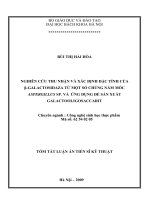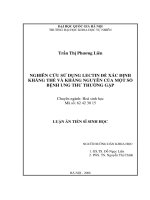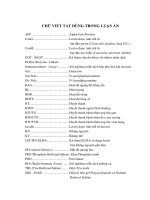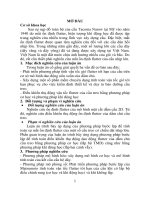Nghiên cứu điều kiện thu nhận, xác định tính chất và thành phần monosaccharide của exopolysaccharide từ một số chủng thuộc loài lactobacillus plantarum tt tiếng anh
Bạn đang xem bản rút gọn của tài liệu. Xem và tải ngay bản đầy đủ của tài liệu tại đây (614.36 KB, 22 trang )
HUE UNIVERSITY
HUE UNIVERSITY OF SCIENCES
TRAN BAO KHANH
STUDY ON PRODUCTION, CHARACTERIZATION AND
MONOSACCHARIDE COMPOSITION OF
EXOPOLYSACCHARIDE FROM Lactobacillus plantarum
Major: Organic chemistry
Code: 62.44.01.14.
HUE - 2019
The work was completed at: University of Sciences – Hue
University
Supervisors:
Assoc. Prof. Dr. Do Thi Bich Thuy
Reviewer 1: Assoc. Prof. Dr. Truong Thi Minh Hanh
Reviewer 2: Assoc. Prof. Dr. Nguyen Le Doan Duy
Reviewer 3: Assoc. Prof. Dr. Pham Xuan Nui
The dissertation will be presented at…………………………:
…………………………………………………………….….
At………h………..month………day…….year………
The thesis is stored at
PREAMBLE
Lactic acid bacteria (LAB) are widely used in food industry
around the world. Beside the lactic acid production, their
biosynthesis of enzymes, bacteriocin and exopolysaccharides are
used to produce probiotics.
Polysaccharides (PS) is used in food and medicine, and has
good mechanical properties for applications such as spinning, film,
glue, thickener, gel forming agent.... Supplies for these PSs are now
primarily from plants such as starch, agar, galactomannan, pectin,
carageenan and aginate. Due to the long-chain structure, these PS can
satisfy the above requirements. However, in order to improve these
properties, almost all plant-derived PS compounds have to be treated
by enzymatic methods and chemical methods. Therefore, their
applicability is still limited.
Besides, the production of EPS from microorganisms has many
advantages over that from plants such as short production time,
inexpensive
culture,
easy
to
control
production
process.
Microorganisms can synthesize many types of polysaccharide such
as
indopolysaccharide,
lipopolysacchride,
peptidoglycan,
exopolysaccharide... In addition, if it is synthesized from safe
microorganisms, polysaccharide will be a safe and biodegradable
material. It is even possible to directly use microorganisms capable
of synthesizing exopolysaccharide into some products.
1
Besides contributing to cellular viability, exopolysaccharide as
well as other polysaccharide compounds have technological
properties that are used as food additives. In Europe and America,
these compounds are often used to improve the quality of dairy
products. They play an important role in increasing the sensory value
of the product. The technology is based on that new product
development.
In addition, EPS from lactic acid bacteria has many positive
effects on human and animal health such as immune enhancing
activity, antiviral, antioxidant, anti-cancer and antihypertensive.
Therefore, production, properties, strucrure and application of
EPS from lactic acid bacteria have been interests of many scientists.
For that reason, we carry out the topic “Study on production,
characterization
and
monosaccharide
composition
of
exopolysaccharide from Lactobacillus plantarum”.
The theme is implemented with the following contents:
1. Determination of exopolysaccharide production conditions
of L. plantarum.
2. Determination of the properties of exopolysaccharides from
L. plantarum.
3. Provide
information
of
exopolysaccharide.
2
structure
of
obtained
4. Initially investigated the possibility of application L.
plantarum to ferment soy milk.
Chương 1.
1.1.
OVERVIEW
Overview of lactic acid bacteria
1.1.1.
Lactic acid bacteria
1.1.2.
Exopolysaccharide from lactic acid bacteria
1.1.3.
Structure and classification exopolysaccharide
1.1.4.
Biosynthesis of exopolysaccharide from lactic acid bacteria
1.2.
Study on exopolysaccharide from lactic acid bacteria
1.2.1.
Exopolysaccharide synthesis conditions
1.2.2.
Exopolysaccharide extraction conditions
1.2.3.
Exopolysaccharide structure
1.2.4.
Exopolysaccharide properties
Chương 2.
2.1.
MATERIAL AND METHODS
Material
2.2.
Chemical
2.2.1.
Culture of microorganisms
2.2.2.
Chemicals of exxopolysaccharide analysis
2.3.
Methods
2.3.1.
Methods of microorganism experiments
2.3.2.
Phenol – sulfuric acid method
2.3.3.
Kjeldahl method
2.3.4.
Exopolysaccharide extraction method
2.3.5.
Determination of solubility of exopolysaccharide method
3
2.3.6.
Determination
of
water
(oil)
holding
capacity
of
exopolysaccharide method
2.3.7.
DPPH free radical scavenging activity
2.3.8.
Monosaccharide composition and methylation analysis of
EPS by GC-MS and NMR
2.3.9.
Molecular weight determination of EPS by gel permeation
chromatography (GPC)
2.3.10. Determining the ability of soybean milk fermentation of L.
plantarum methods
2.3.11. Statistical analysis
Chương 3.
3.1.
RESULT AND DISCUSSION
Exopolysaccharide production ability of L. plantarum
All strains were capable of producing EPS. Five strains having
highest production ability of EPS (W1, W5, W12, T10 and N5) were
selected for further study.
EPS (mg/L)
140.44a
.
97.44b
89.67c
82.39d
66.26e
50.25f 48.17f 47.48f 48.47f
42.46g
L. plantarum
Figure 3.1. Exopolysaccharide production ability of L. plantarum
4
3.2.
Effect of culture conditions on the biosynthesis of
exopolysaccharide of selected L. plantarum strains
3.2.1.
Carbon sources
Table 3.1. Effect of C supplementation on the production of
exopolysaccharide of selected L. plantarum strains
(mg/L)
L. plantarum
W1
W5
W12
T10
N5
C
sources
(%)
0
2
3
4
5
6
Glucose
97.44f
138.00d
150.00c
173.25a
167.19b
135.48e
Lactose
97.44e
148.41d
175.24c
187.35b
203.09a
185.73b
Saccharose
97.44f
111.95e
135.44d
142.60b
150.89a
136.58c
Glucose
66.26d
71.26c
78.57b
79.31b
109.92a
111.87a
Lactose
66.26d
107.48e
110.65d
151.01b
156.13a
123.09c
Saccharose
66.26d
81.74e
122.23c
167.23a
125.28b
107.84d
Glucose
89.67f
110.04e
122.96d
143.41c
171.95a
154.71b
Lactose
89.67f
135.36d
142.64c
169.31b
181.74a
124.06e
Saccharose
89.67f
98.53e
104.06d
125.48b
142.68a
113.33c
Glucose
140.44e
167.47d
195.77c
222.51b
251.01a
224.22b
Lactose
140.44e
177.15d
206.70c
274.83a
243.24b
231.01b
Saccharose
140.44d
176.58c
203.89b
236.74a
174.67c
112.23e
Glucose
82.39f
115.12c
125.97b
151.58a
111.70d
109.87e
Lactose
82.39f
116.91e
157.07d
177.92b
199.31a
171.85c
Saccharose
82.39f
145.69c
183.90a
169.71b
116.46d
109.63e
Different letters in the same row showed statistically significant
differences with p <0.05.
Except saccharose was suitable for W5 strain, lactose was
suitable for the other four strains.
5
Table 3.2. The highest EPS yield in culture medium supplemented
with C source of selected L. plantarum strains
L. plantarum
W1
W5
W12
T10
N5
3.2.2.
The
suitable C
source
Lactose
Saccharose
Lactose
Lactose
Lactose
Concentration
(%)
EPS increase
(%)
5
4
5
4
5
208.43
252.38
202.68
195.69
241.91
Nitrogen sources
Except meat extract was suitable for N5 strain, yeast extract was
suitable for the other four strains.
Table 3.3. Effect of N supplementation on the production of
exopolysaccharide of selected L. plantarum strains
(mg/L)
L. plantarum
N
(%)
sources
W1
W5
W12
T10
N5
Peptone
Meat
extract
Yeast
extract
0
0.2
0.4
0.6
0.8
1.0
0
0.2
0.4
0.6
0.8
1.0
0
0.1
0.2
0.3
0.4
0.5
202.11cd
216.87bc
254.67a
219.67b
206.50bcd
197.60d
202.11e
222.84d
235.65c
286.50a
268.21b
261.87b
202.11e
271.74d
290.52c
315.89a
305.89b
295.89c
166.87a
112.11e
113.70e
120.16d
124.31c
150.40b
166.87c
210.65b
236.38a
119.67d
109.43e
110.16e
166.87e
197.96d
239.06c
260.89b
304.43a
304.06a
182.96f
192.48e
199.55d
216.01c
247.84b
249.92a
182.96f
210.89e
234.92d
258.57a
251.74b
240.65c
182.96d
211.13c
241.74b
277.72a
211.01c
210.28c
273.90a
184.06b
172.23bc
169.54bc
164.79bc
156.01c
273.90b
238.32c
275.03b
286.50b
310.28a
318.08a
273.90c
272.96c
315.40b
318.45b
378.32a
365.52a
199.35c
167.03e
175.73d
239.47b
255.12a
255.08a
199.35d
293.53c
292.76c
295.97b
332.11a
331.42a
199.35f
241.50e
275.12d
308.29b
324.14a
324.96a
Different letters in the same column (in the same group) showed
statistically significant differences with p <0.05.
6
Table 3.4. The highest EPS yield in culture medium supplemented
with N source of selected L. plantarum strains
L. plantarum
W1
W5
W12
T10
N5
The suitable
N source
Yeast extract
Yeast extract
Yeast extract
Yeast extract
Meat extract
Concentration
(%)
0.3
0.4
0.3
0.4
0.8
EPS
increase (%)
156.30
182.44
151.80
138.12
166.60
3.2.3. Initial cell culture density
Except 107 cfu/mL was suitable for N5 strain, 106 cfu/mL was
suitable for the other four strains
EPS (mg/L)
391,30
314,35
306,46
278,90
104
105
106
L. plantarum
343,25
107
108
Initial cell culture density (cfu/mL)
Figure 3.2. Effect of initial cell culture density on the production
of exopolysaccharide of selected L. plantarum strains
3.2.4. Initial pH
Except pH 5.5 was suitable for T10 strain, pH 6 was suitable for
the other four strains.
7
EPS (mg/L)
L. plantarum
397.72
382.03
373.25
325.20
291.66
Initial pH
Figure 3.3. Effect of initial pH on the production of
exopolysaccharide of selected L. plantarum strains
3.2.5.
Incubation temperature
35oC was suitable for W5 and T10 strain, 40oC was suitable for
the other three strains.
EPS (mg/L)
.
410.44
402.76
335.16
378.53
322.76
(oC)
L. plantarum
Figure 3.4. Effect of incubation temperature on the production of
exopolysaccharide of selected L. plantarum strains
3.2.6.
Incubation time
48 hours were suitable for T10 strain, 60 hours were suitable for
W12 strain and 36 hours were suitable for the other three strains.
8
EPS (mg/L)
Incubation time (h)
EPS (mg/L)
Incubation time (h)
EPS (mg/L)
Incubation time (h)
EPS (mg/L)
Incubation time (h)
EPS (mg/L)
Incubation time (h)
Figure 3.5. Effect of incubation time on the production of
exopolysaccharide of selected L. plantarum strains
3.3.
Effect of the extraction conditions on the yeild of
exopolysaccharide obtained
3.3.1.
TCA concentration
9
EPS (mg/L)
Ntotal (mg/L)
TCA (%)
EPS (mg/L)
Ntotal (mg/L)
TCA (%)
EPS (mg/L)
Ntotal (mg/L)
TCA (%)
EPS (mg/L)
Ntotal (mg/L)
TCA (%)
EPS (mg/L)
Ntotal (mg/L)
TCA (%)
Figure 3.6. Effect of TCA concentration extraction conditions on the
yeild of exopolysaccharide
10
20% of TCA was suitable for W1 and T10 strain, 20% of TCA
was suitable for the other three strains.
3.3.2. Ethanol 99% concentration
Supernatant containing EPS and ethanol 99% in 1:1 ratio was
suitable for all the strains.
Table 3.5.Effect of ethanol 99% concentration on the yeild of
exopolysaccharide obtained
(mg/L)
Supernatant
:EtOH
L.plantarum
1:0.5
01:01
01:1.5
01:02
01:2.5
W1
W5
W12
T10
N5
120.36e
444.83a
390.44b
362.19c
360.61c
357.48d
119.31 e
457.35 a
450.57 b
448.13
445.20
438.33
e
a
b
b
c
389.96 d
3.3.3.
78.29
455.12
415.69
393.33
390.16
01:03
142.23 e
451.66 a
446.18 b
415.16 c
404.67 d
404.75 d
98.65 e
540.28 a
453.94 b
425.00
421.54
419.71
Precipitation time
Table 3.6. Effect of precipitation time on the yeild of
exopolysaccharide obtained
(mg/L)
Time (h)
L. plantarum
W1
W5
W12
T10
N5
12
24
36
48
220.57 b
249.14 b
209.10 b
232.35 b
223.98 b
446.18a
458.25 a
456.22 a
453.25 a
539.71 a
445.12 a
455.40 a
456.05 a
454.10 a
539.47 a
443.82 a
454.35 a
455.32 a
452.92 a
537.88 a
24 hours were suitable for all the strains.
11
3.4.
The properties of the exopolysaccharides from the selected
L. plantarum strains
3.4.1.
Water solubility
The water solubility of EPS-W1 and EPS-W12 is higher than
the other three EPSs.
Solubility (%)
85.00a
84.67a
76.33ab
74.00b
72.33b
EPS
Figure 3.7. The water solubility of EPS from the selected L.
plantarum strains
3.4.2. Water (oil) holding capacity
The oil holding capacity of EPS from all the strains is higher
than its the water holding capacity. The water holding capacity and
the oil holding capacity of EPS-W1 are the highest.
WHC/OHC (%)
658,60a
Water holding capacity
Oil holding capacity
333,50b
a
264,98
105,00b
308,40c
101,22c
296,82cd
104,97b
291,67d
104,68b
EPS
Figure 3.8. The water (oil) holding capacity of EPS
from the selected L. plantarum strains
12
3.4.3.
Antioxidant activity
Table 3.7. Antioxidant activity of EPS from the selected L.
plantarum strains
Hydroxyl radical scavenging activity (%)
Concentration
(mg/mL)
EPS-W1
EPS-W5
EPS-W12
EPS-T10
EPS-N5
0.75
32.28
-
-
-
-
1.0
49.85
-
-
-
-
1.5
58.07
36.37
28.59
27.48
-
2.0
70.42
51.67
46.33
46.3
-
2.5
-
63.08
65.12
59.41
23.33
3.0
-
80.16
79.86
71.04
34.42
3.5
-
-
-
-
55.27
3.75
-
IC50
1.01
a
1.95
b
2.1
c
2.14
69.17
c
3.37d
The EPS-W1 hydroxyl radical scavenging is two to three times
higher than the other four EPSs.
3.5.
3.5.1.
Characterization of EPS-W1
Molecular mass of EPS-W1
Figure 3.9. Gel permeation chromatogram of EPS-W1, Molar Mass
Distribution (MMD) pattern
13
The average molecular weight of EPS from L. plantarum W1
was about 1.11x105 Da
3.5.2.
Monosaccharide composition of EPS-W1
Table 3.8. Monosaccharide composition of EPS-W1
No.
1
2
Residues
D-glucose
D-mannose
Ratio
1.49
1.00
(%)
59.90
40.10
EPS-W1’s monosaccharide composition included of glucose
and mannose in 1.49:1 ratio.
Table 3.9. GC-MS data for the alditol acetates derived from
methylated EPS-W1
No.
1
Residues
Glycoside
Ratio
1,5,6-triacetyl-2,3,4-tri-O-
→6)-D-glucopyranoside-(1→
1.00
methyl-D-glucitol
2
3
2,5,6-triacetyl-3,4-di-O-
→2,6)-D- mannopyranoside 0.93
methyl-D-mannitol
-glycoside
1,2,3,5,6-pentaacetyl-4-O-
→2,3,6)-D-
methyl-D-glucitol
4
glucopyranoside-(1→
1,3,5-triacetyl-2,4,6-tri-Omethyl-D-glucitol
5
→3)-D-glucopyranoside-
0,46
(1→
2.5,6-triacetate-1,3,4-tri-
→2,6)-D-
O-methyl-D-mannitol
6
0,49
0.30
mannopyranoside-(1→
1,3,5,6-tetraacetyl -2,4-di-
→3,6)-D-
O-methyl-mannitol
mannopyranoside-(1→
Methylation analysis showed EPS-W1 had six components
Chemical shifts of sugar components are shown in Table 3.10.
14
0.14
Table 3.10. 1H and 13C- NMR chemical shifts (, ppm) of EPS-W1
recorded in D2O at 353 K
(ppm)
Residues
H-1
H-2
H-3 H-4 H-5
H-6
5.76
4.36
4.42 4.43 4.35
4.13 A
5.67
4.57
4.42 4.38 4.36
5.55
4.26
4.31 4.39 4.36
4.24 C
→3)-D-glucopyranoside-(1→
5.37
4.20
4.19 4.39 4.42
4.42 D
2,6)-D-mannopyranoside-(1→
5.59
4.47
4.33 4.48 4.29
4.28 E
→3,6)-D-mannopyranoside-(1→
5.56
4.52
4.32 4.43 4.31
4.32 F
Residues
C-1
C-2
C-3 C-4
C-6
→6)-D-glucopyranoside-(1→
→2,6)-D-mannopyranoside-
glycoside
→2,3,6)-D-glucopyranoside-(1→
→
→6)-D-glucopyranoside-(1→
C-5
-
B
101.3 67.8
70.5 71.1 71.9
61.8 A
94.7
73.2
67.8 67.8 71.0
73.9 B
→2,3,6)-D-glucopyranoside-(1→ 103.4 70.5
71.1 67.7 71.5
67.8 C
→2,6)-D-mannopyranoside glycoside
→3)-D-glucopyranoside-(1→
→2.6)-D-mannopyranoside-(1→
→3,6)-D-mannopyranoside-(1→
94.4
71.5
72.8 63.4 71.9
71.4 D
99.1
69.4
70.5 73.2 71.5
67.8 E
102.7 70.5
67.8 71.4 73.2
67.8 F
Based on the NMR and monosaccharide composition analysis,
the sugar chain of EPS-W1 could be similar to structure shown in
Figure 3.10
α- D- Glcp -(1→6)-α-D- Manp
(A)
(E) 1
↓
2
α-D- Manp -(1→6)-α-D- Glcp-(1→3)- α -D- Manp-(1→3)- α -D- Glcp-(1→
(B)
(C)
(F)
(D)
Figure 3.10. Structure of the surgar chain of EPS-W1
15
3.6.
The gel-forming ability of fermented soybean milk of
selected L. plantarum strains
3.6.1.
Effect of inocubation time on fermented soybean milk gel.
Gel of soybean fermented by L. plantarum W1 was the highest.
Table 3.11. Gel state of soybean milk fermented by L. plantarum
No.
L. plantarum
1
Gel
State
3h
6h
9h
12 h
W1
-
+
++
+++
Smooth, fat
2
W5
-
+
++
+++
Smooth, fat
3
W4
-
+
+
++
Smooth, soft
3.6.2.
-
: Liquid
+
: Paste
++
: Gel, no water separation
+++
: Gel cracked, separated water
The water holding capacity of fermented soybean milk
WHC (%)
78,38a
69,62 b
50,56c
L. plantarum
Figure 3.11. The water holding capacity of soybean milk
fermented by L. plantarum
16
The water holding capacity of soybean milk fermented by L.
plantarum W1 was the highest.
3.6.3.
The viscosity of fermented soybean milk
The viscosity of soybean milk fermented by L. plantarum W1
was the highest.
Viscosity (Pa.s)
L. plantarum
Share rate (s-1)
Figure 3.12. The viscosity of soybean milk fermented by L. plantarum
CONCLUSION
1. The best EPS conditions for Lactobacillus plantarum strains
are as follows:
- Lactobacillus plantarum W1: MRS supplemented with 5%
lactose, 0.3% yeast extract, pH 6, initial cell culture density is 106
CFU/mL. Fermented temperature and time were 40°C and 36 hours.
Using 20% TCA to remove protein and precipitate EPS by ethanol
17
with ratio: fermentation solution is 1: 1 for 24 hours. With above
condition, the yield of EPS-W1 was 446.18 mg/L.
- Lactobacillus plantarum W5: MRS supplemented with 4%
saccharose, 0.4% yeast extract, pH 6, initial culture density was 106
CFU/mL. Fermented temperature and time were 35 oC and 36
hours. Using 25% TCA to remove protein and precipitate EPS by
ethanol with ratio: fermentation solution is 1: 1 for 24 hours. With
above condition, the yield of EPS-W5 was 458.25 mg/L.
- Lactobacillus plantarum W12: MRS supplemented with 5%
lactose, 0.3% yeast extract, pH 6, initial culture density was 106
CFU/mL. Fermented temperature and time were
40 °C and 60
hours. Using 25% TCA to remove protein and precipitate EPS by
ethanol with ratio: fermentation solution is 1: 1 for 24 hours. With
above condition, the yield of EPS-W12 was 456.22 mg/L.
- Lactobacillus plantarum T10: MRS supplemented with 4%
lactose, 0.4% yeast extract, pH 5.5, initial cell culture density was
106 CFU/mL. Fermented temperature and time were 35 °C and 48
hours. Using 20% TCA to remove protein and precipitate EPS by
ethanol with ratio: fermentation solution is 1: 1 for 24 hours. With
above condition, the yield of EPS-T10 was 454.10 mg/L.
- Lactobacillus plantarum N5: MRS supplemented with 5%
lactose, 0.8% meat extract, pH 6, initial culture density was 106
CFU/mL. Fermented temperature and time were 40 °C and 36 hours.
Use 25% TCA to remove protein and precipitate EPS by ethanol
18
with ratio: fermentation solution is 1: 1 for 24 hours. With above
condition, the yield of EPS-N5 was 539.71 mg/L.
2. Water solubility, water holding, oil holding and antioxidant
capacity of EPS-W1 were better than the other EPSs.
3. The average molecular weight of EPS-W1 was 1.11x105 Da.
EPS-W1’s monosaccharide composition included of glucose and
mannose in 1.49:1 ratio. The repeating unit of this polysaccharide to
be shown -D-(1 → 6)-linked glucosyl,-D-(1 → 3)-linked mannosyl, D-(1 → 3)-linked glucosyl and branch of -D-(1→6)-linked
mannosyl, -D-(1 → 2)-linked glucosyl.
4. Initially, survey showed that L. plantarum W1 could be
applied to fermented soybean milk.
SUGGESTION
- Finding cheaper exopolysaccharide production conditions.
- Investigating some other beneficial properties of EPS such
as antibacterial, anti-inflammatory ...
- Studying on the possibility of applying of the EPSs in other
fields such as food and pharmaceuticals.
19
LIST OF RELATED SCIENTIFIC ARTICLE
1.
Tran Bao Khanh, Do Thi Bich Thuy, Doan Thi Thanh Thao
(2016), Optimal conditions for high exopolysaccharide production by
Lactobacillus plantarum T10, Journal of Science and Technology, 52
(44), 10-47.
2.
Tran Bao Khanh, Đo Thi Bich Thuy (2016),
Optimal
conditions for exopolysaccharide production by Lactobacillus
plantarum W5, Hue University Journal of Science, 121 (7). 57-68.
3.
Tran Thi Ai Luyen, Tran Bao Khanh, Do Thi Bich Thuy, Tran
Thi Van Thi
(2017), Study on some extraction conditions and
structural characterisation of exopolysaccharides produced by
Lactobacillus fermentum MC3 and
Lactobacillus
plantarum
W12, Vietnam Journal of Chemistry, 55 (4E23), 243-249.
4.
(2017),
Tran Bao Khanh, Tran Thi Ai Luyen, Do Thi Bich Thuy
Determination
of
molecular
weights
and
some
physicochemical characterizations of exopolysaccharides produced
by Lactobacillus fermentum MC3 and Lactobacillus plantarum W12,
Vietnam Journal of Chemistry, 55 (4E34), 17-21.
5.
Tran Bao Khanh. Do Thi Bich Thuy. Nguyen Tran Bao
Khuyen (2017), Effect of some conditions on exopolysaccharide
production of Lactobacillus plantarum N5, Journal of Science and
Technology (Hue University of Sciences), 1 (10), 131-141.
20
![[Luận văn]xác định liều lượng và dạng lân bón thích hợp cho một số giống lạc trong điều kiện vụ xuân tại huyện nho quan ninh bình](https://media.store123doc.com/images/document/13/gu/bo/medium_bok1375974185.jpg)








